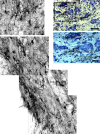Combining an autologous peripheral nervous system "bridge" and matrix modification by chondroitinase allows robust, functional regeneration beyond a hemisection lesion of the adult rat spinal cord
- PMID: 16837588
- PMCID: PMC6674179
- DOI: 10.1523/JNEUROSCI.1166-06.2006
Combining an autologous peripheral nervous system "bridge" and matrix modification by chondroitinase allows robust, functional regeneration beyond a hemisection lesion of the adult rat spinal cord
Abstract
Chondroitinase-ABC (ChABC) was applied to a cervical level 5 (C5) dorsal quadrant aspiration cavity of the adult rat spinal cord to degrade the local accumulation of inhibitory chondroitin sulfate proteoglycans. The intent was to enhance the extension of regenerated axons from the distal end of a peripheral nerve (PN) graft back into the C5 spinal cord, having bypassed a hemisection lesion at C3. ChABC-treated rats showed (1) gradual improvement in the range of forelimb swing during locomotion, with some animals progressing to the point of raising their forelimb above the nose, (2) an enhanced ability to use the forelimb in a cylinder test, and (3) improvements in balance and weight bearing on a horizontal rope. Transection of the PN graft, which cuts through regenerated axons, greatly diminished these functional improvements. Axonal regrowth from the PN graft correlated well with the behavioral assessments. Thus, many more axons extended for much longer distances into the cord after ChABC treatment and bridge insertion compared with the control groups, in which axons regenerated into the PN graft but growth back into the spinal cord was extremely limited. These results demonstrate, for the first time, that modulation of extracellular matrix components after spinal cord injury promotes significant axonal regeneration beyond the distal end of a PN bridge back into the spinal cord and that regenerating axons can mediate the return of useful function of the affected limb.
Figures









References
-
- Aguayo AJ, David S, Bray GM (1981). Influences of the glial environment on the elongation of axons after injury. J Exp Biol 95:231–240. - PubMed
-
- Berardi N, Pizzorusso T, Maffei I (2004). Extracellular matrix and visual cortical plasticity: freeing the synapse. Neuron 44:905–908. - PubMed
-
- Bertolotto A, Manzardo E, Guglielmone R (1996). Immunohistochemical mapping of perineuronal nets containing chondroitin sulfate proteoglycan in the rat central nervous system. Cell Tissue Res 283:283–295. - PubMed
-
- Bradbury EJ, Moon LD, Popat RJ, King VR, Bennett GS, Patel PN, Fawcett JW, McMahon SB (2002). Chondroitinase ABC promotes functional recovery after spinal cord injury. Nature 416:636–640. - PubMed
-
- Bregman BS (1994). Recovery of function after spinal cord injury: transplantation strategies. In: Functional neural transplantation (Dunnett SB, Bjorklund A, eds) pp. 489–529. New York: Raven.
Publication types
MeSH terms
Substances
Grants and funding
LinkOut - more resources
Full Text Sources
Other Literature Sources
Medical
Miscellaneous
